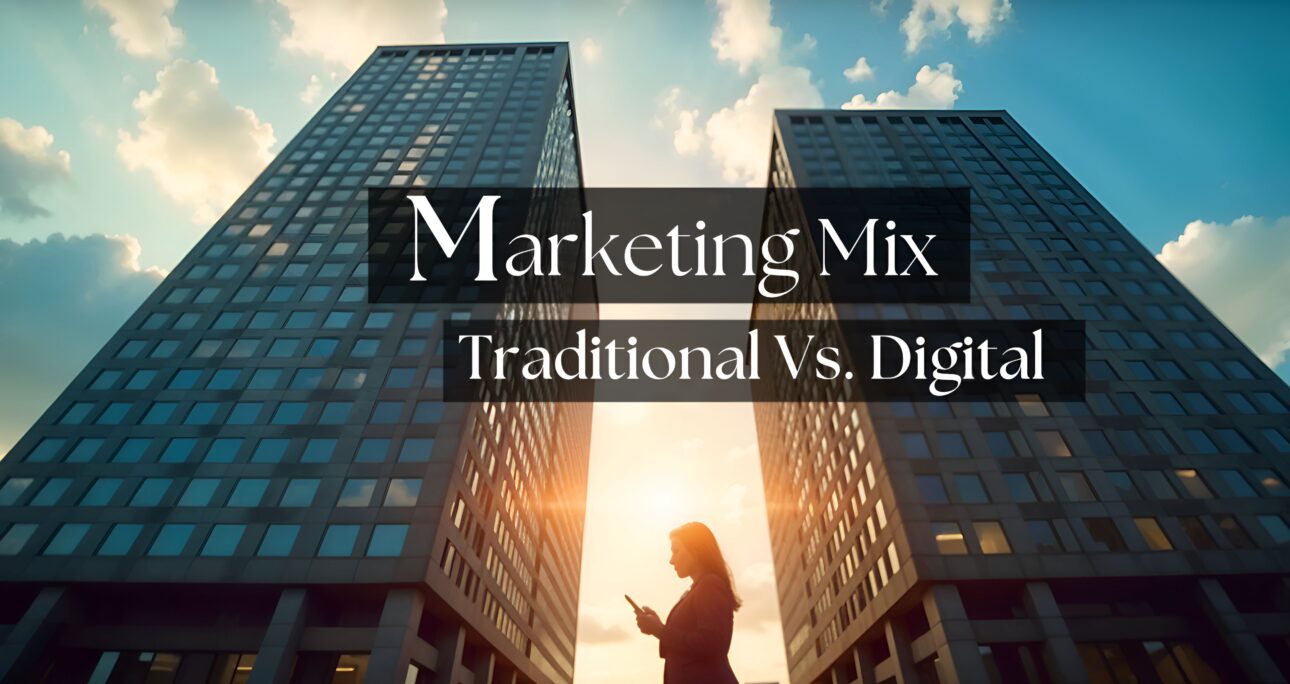The real estate industry has undergone significant changes over the past decade, driven by technological advancements and shifting consumer preferences. Today, real estate developers need a balanced approach, combining both traditional and digital marketing strategies to reach their target audience effectively. In this article, we’ll explore the marketing mix for real estate development, comparing traditional methods with innovative digital approaches.
Introduction to the Marketing Mix
The marketing mix, also known as the 4Ps (Product, Price, Place, Promotion), is a set of tools used to influence buyer behavior. For real estate developers, understanding and applying the marketing mix is crucial for attracting potential buyers and investors in an increasingly competitive market. Learn more about the marketing mix.
Product
In real estate, the product refers to the property itself, whether it’s residential, commercial, or industrial. It must align with the specific needs of the target audience. Elements such as location, design, amenities, and sustainability play key roles in defining the product. Consumer preferences regarding these factors evolve, which can further impact the appeal of the property.
Price
Pricing strategies in real estate depend on market conditions, property demand, and unique features. Traditionally, pricing involved market comparisons and expert analysis. Today, digital tools such as AI and big data offer more precise pricing models, enabling developers to make data-driven decisions. These tools analyze market trends and buyer behavior, improving accuracy in pricing.
Place
The place aspect of the marketing mix involves how buyers access properties. Traditionally, real estate relied on physical offices, open houses, and real estate agents to connect with buyers. With the rise of digital platforms, online listings, virtual tours, and real estate marketplaces now offer more accessible ways for buyers to explore properties. This shift has expanded the reach of real estate marketing, allowing global access.
Promotion
Promotion encompasses all the activities aimed at promoting a property to potential buyers. Traditional methods like print ads, billboards, and direct mail were once dominant. However, digital strategies have taken the lead. Social media, email marketing, SEO, and content marketing now provide more efficient ways to engage with a wider audience. These methods also allow for personalization, making promotional efforts more impactful.
Traditional Marketing Mix for Real Estate
Traditional Product Strategies
In the past, real estate marketing focused heavily on showcasing the physical aspects of a property. Developers relied on brochures, physical models, and in-person tours to highlight the property’s features. These methods helped buyers visualize the space, which was essential for securing interest.
Traditional Pricing Strategies
>Traditional pricing methods involve comparing properties in similar markets and relying on real estate agents’ expertise. Open houses and auctions also helped gauge interest and determine the final selling price. These strategies often depended on market conditions and the perceived value of the property.
Traditional Place Strategies
Historically, a physical presence was critical for real estate sales. Open houses, real estate offices and in-person meetings were the main channels for connecting with potential buyers. Additionally, word-of-mouth and personal relationships were essential for reaching interested clients.
Traditional Promotion Strategies
Traditional promotion strategies relied on print media, television, radio, and outdoor advertising. Direct mail campaigns and telemarketing were widely used to reach potential buyers. These methods, while effective, primarily targeted local audiences and required substantial time and effort.
Digital Marketing Mix for Real Estate
Digital Product Strategies
In contrast, digital marketing offers innovative ways to showcase real estate products. Virtual tours, 3D renderings, and augmented reality (AR) allow buyers to explore properties from the comfort of their homes. Websites and mobile apps provide detailed property information, making it easier for buyers to engage with the listings.
Digital Pricing Strategies
Digital tools have revolutionized pricing strategies. AI and big data help developers analyze buyer behavior and market trends, allowing for more accurate pricing. Online platforms also offer transparency, enabling buyers to compare prices more easily, which can lead to better decision-making.
Digital Place Strategies
The internet has become the primary channel for real estate transactions. Online listings, virtual open houses, and webinars allow developers to reach a broader, global audience. Real estate portals and social media platforms are now the go-to places for buyers to explore potential properties, reducing the need for physical presence.
Digital Promotion Strategies
Digital promotion provides more targeted and efficient ways to reach buyers. Social media campaigns, SEO, and PPC ads help attract specific demographics. Additionally, content marketing, including blogs and videos, helps build brand authority, while email marketing ensures personalized engagement.
Comparing Traditional and Digital Marketing Mix
Reach and Accessibility
Digital marketing offers greater reach and accessibility than traditional methods. Online platforms allow developers to target specific demographics and reach global audiences. On the other hand, traditional marketing is effective at building local presence but lacks the broad reach of digital strategies.
Cost-Effectiveness
Digital marketing tends to be more cost-effective. Social media ads, online campaigns, and email marketing offer a higher ROI compared to print or television ads. Traditional marketing methods are often more expensive and less scalable.
Engagement and Interaction
Digital platforms provide more opportunities for interaction and engagement with potential buyers. Social media, live chats, and interactive websites facilitate real-time communication. In contrast, traditional marketing methods rely more on in-person meetings, which are less scalable and often time-consuming.
Data and Analytics
One of the biggest advantages of digital marketing is the ability to gather real-time data. Analytics tools help track buyer behavior, campaign performance, and market trends. This allows developers to adjust their strategies quickly. Traditional marketing, on the other hand, offers limited data and often depends on subjective assessments.
Conclusion
The marketing mix for real estate development has evolved with the rise of digital technologies. While traditional methods still play a role in establishing trust and building personal relationships, digital strategies offer greater reach, efficiency, and data-driven insights. Ultimately, real estate developers need to embrace both approaches to remain competitive and meet the growing demands of the modern market.
By combining the strengths of both traditional and digital methods, developers can create comprehensive marketing strategies that appeal to today’s diverse and tech-savvy buyers.
Visit Our Site: The Crow Studio & enhances real estate 💡✨





